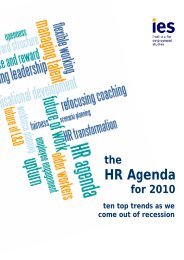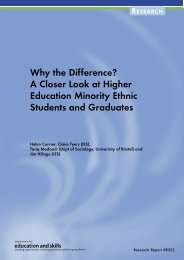Post-16 Transitions: a Longitudinal Study of Young People with ...
Post-16 Transitions: a Longitudinal Study of Young People with ...
Post-16 Transitions: a Longitudinal Study of Young People with ...
You also want an ePaper? Increase the reach of your titles
YUMPU automatically turns print PDFs into web optimized ePapers that Google loves.
and most reported that they had more friends than before, and<br />
had a clearer idea <strong>of</strong> what they wanted to do in the future. The<br />
case studies also found that some <strong>of</strong> the most important outcomes<br />
for young people post-<strong>16</strong> were in social and personal<br />
development rather than academic and vocational achievement.<br />
Having said this, there remained a small, but not insignificant,<br />
number <strong>of</strong> young people who had not achieved any additional<br />
outcomes eg qualifications or social development gains, since<br />
completing compulsory schooling. The case studies particularly,<br />
observed young people who had made little or no progress since<br />
Year 11, and who appeared to be rather aimlessly engaged (or<br />
floundering) in their post-<strong>16</strong> activity, and heavily reliant on<br />
support workers and parents for social contact and friendship.<br />
10.4 Two key groups<br />
From the survey and the case studies, two groups <strong>of</strong> young people<br />
stand out:<br />
• The first group relates to young people <strong>with</strong> largely<br />
uncontested impairments (eg sensory and/or physical<br />
disabilities) that have been identified at (or before) school.<br />
These young people generally have a statement, have attended<br />
a special school (or special provision in a mainstream school)<br />
and had multi-agency intervention related to their<br />
impairment. Essentially, these young people constitute a fairly<br />
well-known population for whom there are clear transition<br />
pathways, although many are experiencing deferred<br />
transitions in post-<strong>16</strong> education. The issues for them are<br />
whether the pathways they are on are appropriate, whether<br />
they promote genuine progression and whether the high level<br />
<strong>of</strong> service co-ordination these young people need (and that<br />
they have experienced pre-<strong>16</strong>) actually survives the transition<br />
phase.<br />
• The second group <strong>of</strong> young people are those <strong>with</strong> less welldefined<br />
or evident impairments eg less severe learning<br />
difficulties, and behavioural, emotional or social development<br />
needs who effectively form part <strong>of</strong> a broader population <strong>of</strong><br />
educational low-attainers. They are most likely to have<br />
attended mainstream schools, are less likely to have had<br />
statements <strong>of</strong> SEN or well-defined transition pathways, and<br />
the level <strong>of</strong> statutory support they have received to date<br />
appears to be low. Many have left education and have entered<br />
or are seeking to enter the bottom end <strong>of</strong> the labour market.<br />
The issue for these people is whether the mainstream ‘systems’<br />
<strong>with</strong>in which they operate, including the education system<br />
and the labour market, are sufficiently powerful to overcome<br />
the (sometimes significant) difficulties that these young people<br />
face. There is considerable evidence already that this may not<br />
be the case.<br />
<strong>Post</strong>-<strong>16</strong> <strong>Transitions</strong> <strong>of</strong> <strong>Young</strong> <strong>People</strong> <strong>with</strong> SEN: Wave 2 143

















